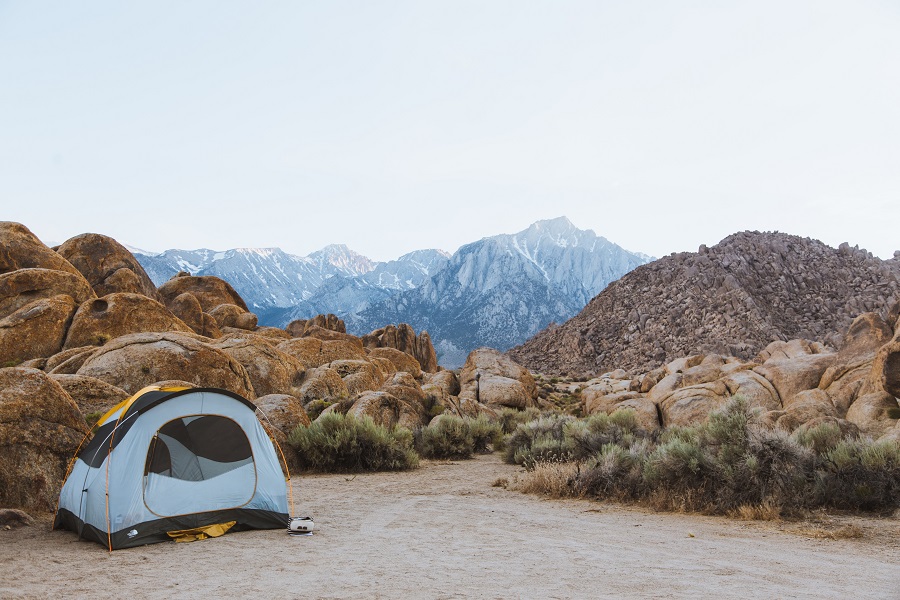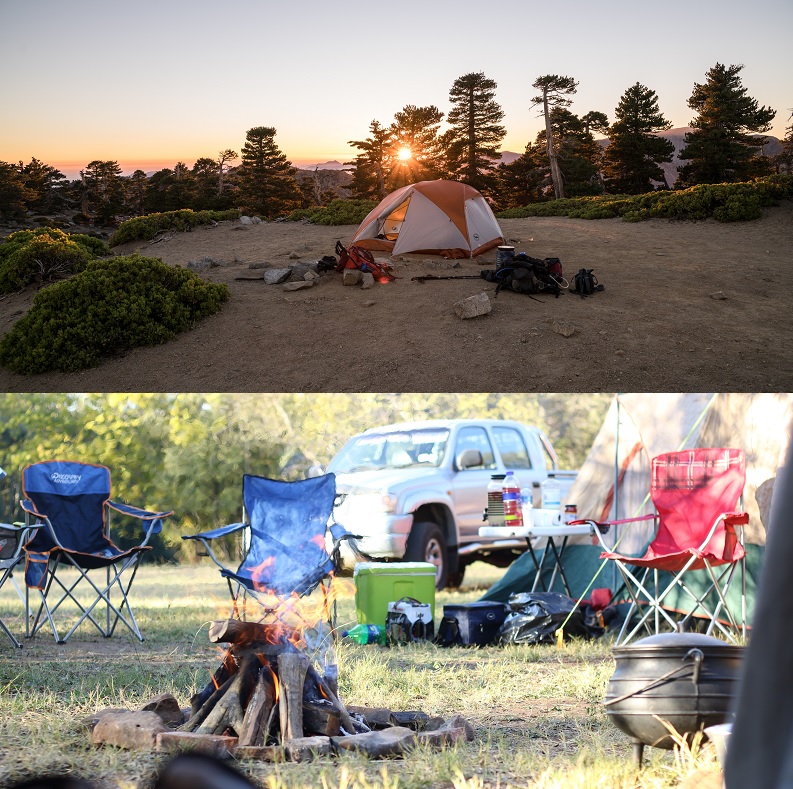While out camping a few weeks ago I came across a campsite that was just perfect. It had amazing views, decent shelter and not too far from water. The only problem was it was on hard ground.
So after some research I found that the best way to pitch a tent on hard ground will depend if its rocky, firm or frozen. Not only are there different pegs that you can use but in some cases you can leave the pegs at home. So read on to find the best method that you can use that will suit your terrain.
Camping on Dry Ground
During the summer months the ground can dry out which makes it hard. If you’re using the standard pegs that are supplied with your tent then they are likely to bend. Rather than running out and buying new stronger pegs there is a simply trick you can do that will work on any dry ground.
Simply wet it again. Lay out your tent and mark where the pegs will go. Then just get a bottle of water and pour it on the ground where the pegs will be set. Depending on the ground, you may have to wait a few minutes until the water soaks down. Drive the peg into the now soft ground.
Note, if the peg is stopping halfway down then remove the peg and pour a little more water down the hole that the peg has just made. Wait a few more minutes for the ground to soften then try again.
Camping on soft surface with rocks underneath
I don’t know how many times I’ve went the set my tent in what looks like ideal ground only to find there are stones just under the surface. This can be a real pain because you can’t see if it is clear or not. Are you hitting a big rock or just a small stone? I’ve bent a lot of pegs searching for a “clear spot”
In cases like this, it is best to have sturdy pegs that don’t bend easily. They are able to push smaller stones out of the way. Stones that would normally bend a weaker peg.
Camping on a solid ground like large boulder
Sometimes the only clear, flat ground is solid ground. Obviously, you won’t be driving any pegs into solid rock unless you have steal nails and a heavy hammer. Don’t do this.
So what is one to do? The purpose of pegs are to anchor your tent in place so that it won’t blow away, or in some cases, to hold it up. So when we can’t use pegs all we have to do is find another way to anchor your tent.
Simply loop some paracord through the pegs hoops and the tie it to a heavy stone. Do this with all the peg hoops and your tent is going nowhere. If there aren’t any rocks around then tying your tent to two large logs lying either side of the tent will do the same thing.
Camping on loose stones
This is probably the most tricky of all. The easiest thing to try is to do the same as above and just tie the tent the larger objects. However, if there aren’t any large object you could use, then there is another option. If the stone is loose enough to be removed by hand then you could remove some stones to make a hole. Tie the paracord to the tent like above then instead of tying it to a large object you can instead tie it to a smaller stone or log. Place the stone or log into the hole and then place the stone back in on top to fill the hole again. Obviously the deeper you go the stronger the anchor point will be.
Camping in frozen ground
Camping during the winter will give many challenges. However, pitching your tent shouldn’t be one of them. Just to clarify here, I am talking about frozen ground. Not ice or snow.
You have two options here depending on your surroundings. You could just go with the anchoring to large object method or if you have a good campfire going the you could try the following.
Lay out your tent and mark where the pegs will go. Now boil some water and pour it where you will be driving the pegs. The pegs should now be easily driven into place. Note that when you want to remove the pegs the next day, they will probably be frozen in place. Simply repeat the process and pour some hot water over the pegs and then remove the pegs.
Types of stakes/pegs
Standard wire pegs that come with most tents
These are fine for soft ground but if you are camping in areas where the ground is hard or rocky then these will be no good to you. They are the most affordable option but the do bend easily.
The V-shape peg
These are a great all rounder. Good for firm to soft ground and because of their design and strong material they can take a good bit of abuse without bending. They can be bought in a range of materials like plastic, steel and titanium. The plastic are light and cheap but wont suit hard ground. Titanium is also light and will tackle any type of ground but is expensive. If you are car camping or don’t mind carrying a little extra weight then the steel one will do the job well.
The delta peg
These are hook shaped pegs. Half of the peg sticks into the ground and the other half runs parallel to the ground where you attach the guy line. I haven’t used them myself but I have heard good things about them. They would only suit soft to firm ground. They are designed to catch the ground and hold more if they are being pulled. When they are in place nothing sticks over the ground so no more stubbing your toes.
The Rock peg
When camping in areas where you know is rocky them these are the ones you need. These are basically a giant steel nail with a hook on top so you can attach your tent. Very good for hard ground or in places where there are lots of rocks under the surface. However, they are not for solid rock. You will spend an awful long time trying to drive these into solid rock. They aren’t much good for soft ground either as they will just pull out easily.
Screw peg
These are only good for soft to firm ground with no rocks. They’re also not really practical for long hike as you need a power drill to screw them into the ground. They can be screwed into the ground manually but this makes it a lot harder than traditional peg to plant into the ground. That said, if you know where you are camping has soft to firm ground and you are car camping these are ideal. Once in place they will not be going anywhere.
Custom pegs
There are some homemade pegs that I seen people using over the years. One is 8 inch long lag bolts. They were only threaded 2/3rds of the way up so as not to chew on the paracord. It also had a washer around the head to stop the paracord from slipping off. It works very well on hard and rocky ground however you will need a way for driving the screws into the ground. For this reason it is best left to car camping as a power drill will need to be used. Unless you want to be hiking with a power drill?
I’ve even seen people use pet stacks. These worked great on really soft ground. I don’t think they would be of any advantage on harder ground and they would be very difficult to screw.
All of the above are good when they are used on the correct ground. The easiest way to remember which one to use is if the softer the ground the wider the peg. If the ground is hard then use narrow pegs.
The best way to drive your pegs
Having the right peg is important but you also have to know how to use it. While just driving your peg into the ground any which way may do sometimes there is a way to do it to ensure they stay where they should every time.
Driving the pegs straight down or, even worse, in line with guy line will make it easier for them to be pulled out. However, when the peg is placed perpendicular to the guyline it will make it impossible for the peg to be pulled out. The only way it can come free is if the ground gives way. Another advantage to this method is that the pegs won’t have to go as deep so you are less likely to hit stone.
Hammers for driving pegs
If you’re car camping then you don’t have to worry about weight. In these cases I use my claw hammer because I had one already. It’s good for hammering in the pegs and when I’m done I can use the back the pull the pegs out.
As I said, I already had one of these so I didn’t have to go out and buy one for camping. If you need one and you know you are just going to be using it for camping then I suggest getting a dedicated tent hammer.
If I’m going on a long hike I’ll leave the hammer at home. You will always find something in the wild that will do the job. The first thing to try is the stand (not stamp) on it if you’re wearing hiking boots. Stamping could result in the pegs piercing your foot.
If that doesn’t work try to find on old branch and use it as a hammer. If there are no branches or if it’s just not heavy enough you can use a rock. However, by careful not to injure yourself. Make sure all fingers are out of the way and remember that some rocks can split easily.
In the end I was able to use a combination of the above. Some of the pegs could be driven in at an angle and the others a tied to rocks that were lying around. Camping is about using what you have around and to work with the environment you are in. If you try to work against it, you will lose.
If you have found this article helpful then please remember to share by clicking on one of the buttons below. It will help others find this article too.



